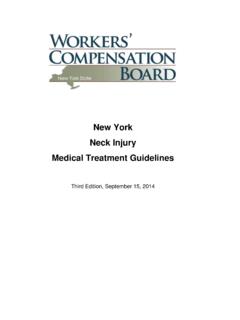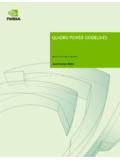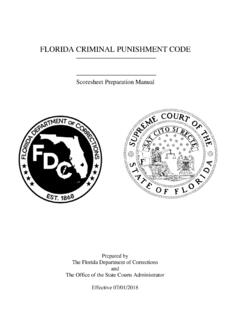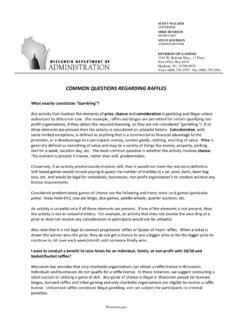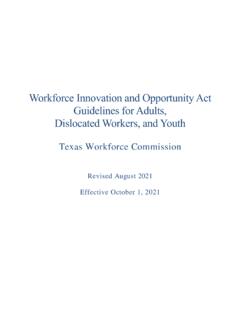Transcription of REVIEW EDITOR GUIDELINES - Frontiers
1 REVIEW EDITOR GUIDELINES . Welcome to the Frontiers community of Editors. The following GUIDELINES are meant to provide you with further practical information regarding your role as REVIEW EDITOR as well as the Frontiers peer- REVIEW process and platform. Should you have any questions, please feel free to contact the journal team directly using their field Editorial Office account. Last updated on: 22 October 2021. TABLE OF CONTENTS. 1. Frontiers ' EDITORIAL BOARD 3. 2. HOW-TO'S FOR YOUR ROLE AS REVIEW EDITOR 3. SHOWCASE YOUR EXPERTISE ON LOOP 3. REVIEW MANUSCRIPTS 5. CONTRIBUTE TO THE SECTION'S EDITORIAL DEVELOPMENT 5. 3. THE Frontiers REVIEW PROCESS 6. INITIAL VALIDATION 7. EDITORIAL ASSIGNMENT - INITIAL ASSESSMENT 9. DECLARE CONFLICTS OF INTEREST 10. THE INDEPENDENT REVIEW PHASE 12. THE INTERACTIVE REVIEW PHASE 15. MAKING A FINAL DECISION 17.
2 Endorsing for publication 18. Withdrawing and/or recommending rejection 19. FINAL VALIDATION 21. REQUESTING AN EXTENSION 21. 4. CONTACT DETAILS 21. 2 Frontiers | REVIEW EDITOR GUIDELINES 1. Frontiers ' EDITORIAL BOARD. Editorial boards comprise 4 distinct roles, whose responsibilities are divided as follows: 1. The Field Chief EDITOR oversees the entire journal and acts in collaboration with the Editorial Office to assist and guide the Specialty Chief Editors. 2. The Specialty Chief Editors oversee the individual journal specialties. They also build a board of 15-20. Associate Editors for their own specialty. 3. The Associate Editors act as handling editors for submitted manuscripts, accepting them for publication following peer- REVIEW , or recommending rejection to the Specialty Chief EDITOR . Associate Editors also invite REVIEW Editors to the editorial board and can invite external reviewers for peer- REVIEW .
3 4. The REVIEW Editors act as reviewers for submitted manuscripts, engaging with the authors, Associate EDITOR and each other in an interactive REVIEW forum. To learn more about the different roles on the editorial board, please click here. NOTE: The following GUIDELINES mention both REVIEW Editors and reviewers . While the former specifically refers to REVIEW Editors on the editorial board, the latter encompasses both REVIEW Editors and external reviewers invited by the Associate Editors to REVIEW specific manuscripts. 2. HOW-TO'S FOR YOUR ROLE AS REVIEW EDITOR . SHOWCASE YOUR EXPERTISE ON LOOP. To join the editorial board, you created an account on our research network, Loop, which will allow you to receive invitations and access your REVIEW assignments. We ask that you complete your profile by adding a photo, a brief bio, and a list of your publications.
4 To add publications to your Loop profile, visit the relevant tab and go through the suggested list and confirm/reject records, as needed. 3 Frontiers | REVIEW EDITOR GUIDELINES From your loop profile you will gain access to My Frontiers (1). My Frontiers is an interface that allows all Submissions, REVIEW and Editing assignments, as well as other useful information, to be viewed in one place. My Frontiers can be accessed in the top-right corner of your browser after logging in. Once clicking on My Frontiers , by selecting Tabs I can view in one place: All My Submissions and where they are in the REVIEW Process My Editing Assignments My Inbox My Invoices Useful information for my EDITOR Role(s). 4 Frontiers | REVIEW EDITOR GUIDELINES REVIEW MANUSCRIPTS. The primary role of REVIEW Editors is to act as reviewers in the peer- REVIEW of submitted manuscripts.
5 Along with Associate Editors, REVIEW Editors (including yourself) are the key persons of the Frontiers REVIEW process, since they are responsible for certifying the validity and accuracy of publications, and for helping authors to improve the quality of their manuscripts as well as the way in which the research is communicated. YOUR RESPONSIBILITIES AS A REVIEWER. The mandate for reviewers is to: ensure that experiments and studies were conducted correctly, taking into account appropriate ethical considerations, and that the conclusions are based on a valid, logical interpretation of the results. Reviewers are obliged to: keep all manuscript files and REVIEW reports confidential. These should only be shared with the authors and the handling EDITOR of the manuscript in the REVIEW forum. Posting of the REVIEW report publicly is prohibited.
6 Refrain from disclosing their identity to the authors and other reviewer(s) until after completing the REVIEW process. refrain from using inappropriate language and unconstructive behavior. This will not be tolerated and may result in a reviewer being revoked from the assignment and, in more serious cases, from the editorial board. ensure a timely REVIEW by completing their assignment as soon as possible and by notifying the handling EDITOR and Editorial Office of any expected delays immediately. Please see additional GUIDELINES for reviewers issued by the Committee on Publication Ethics, that detail further ethical obligations of reviewers, here. CONTRIBUTE TO THE SECTION'S EDITORIAL DEVELOPMENT. Although this is not compulsory, you are also encouraged to be an active member of the editorial board and contribute to the success of the specialty by: Submitting your own manuscripts on a regular basis.
7 Suggesting or/and co-editing a Research Topic article collection Promoting Frontiers to your peers and colleagues. CONSIDER ORGANIZING A RESEARCH TOPIC. Frontiers Research Topics are collections of ideally at least 10 articles on a focused research area. They create an online dialogue between many research groups about their latest advances, methods, ideas, and more. They are a great opportunity to highlight your research focus, intensify collaboration, and drive the next developments in your field. The organization of Research Topics resembles the format of a conference, with researcher-proposed topics and abstract submissions for proposed contributions. They result in an encyclopedic collection of peer- reviewed articles available to everyone both online and as a free, downloadable e-book (see here for an example). 5 Frontiers | REVIEW EDITOR GUIDELINES We recommend that Research Topics be hosted by a minimum of two Topic Editors with previous editing experience, who may be assisted by an Associate EDITOR from the editorial board if deemed appropriate by the Specialty Chief EDITOR .
8 Topic Editors are responsible for soliciting contributions from their peers (although submissions are open to all), for selecting contributions based on abstract submissions, as well as for overseeing the REVIEW process of submitted manuscripts by acting as the handling editors. Feel free to contact us with any ideas you have for potential Research Topics, including those that could be hosted by other experts in the field. Research Topic proposals will need to be approved by the Specialty Chief EDITOR of the relevant specialty. 3. THE Frontiers REVIEW PROCESS. The Frontiers collaborative REVIEW process has been designed to validate high-quality scholarly contributions by fostering objectivity, rigor, and iterative collaboration. Associate Editors and reviewers are acknowledged publicly on all published articles. As shown below the REVIEW process is composed of seven stages: Initial Validation, Editorial Assignment, Independent REVIEW , Interactive REVIEW , REVIEW Finalized, Final Validation and Final Decision.
9 REVIEW Editors join the process at the stage of the Independent REVIEW and follow discussions with authors through Interactive REVIEW till they are ready to make their final decision. REVIEWER ROLE. In the following sections each stage of the REVIEW process is outlined in further detail. 6 Frontiers | REVIEW EDITOR GUIDELINES INITIAL VALIDATION. To support you in ensuring the quality of the articles, all submissions undergo standard initial checks by the Research Integrity team. All submissions are pre-screened for: Textual overlap with and similarity to published material. Potential image or data manipulation. Language Quality;. Adherence to editorial policies Adherence to ethical standards;. Potential conflicts of interest. More information on the Frontiers Research Integrity policies can be found at the following link: A webinar explaining the activities of our Research Integrity team is also available: YouTube BiliBili.
10 Following completion of these initial checks, the manuscripts are sent to a relevant Associate EDITOR on the board. AIRA ARTIFICIAL INTELLIGENCE REVIEW ASSISTANT. Frontiers peer REVIEW incorporates powerful AI technology to safeguard both manuscript and peer- REVIEW quality more efficiently. AIRA assists editors, reviewers, and internal teams by analyzing, interpreting, and communicating the quality of submitted manuscripts. Its algorithms quickly and accurately evaluate submitted manuscripts against a set of quality measures, including: 1) Ethics GUIDELINES 2) The presence of human images 3) Text overlap 4) Language quality 5) Scope verification 6) Duplicate submissions 7) Controversial topics 8) Commercial Conflicts 9) Data Availability verification 7 Frontiers | REVIEW EDITOR GUIDELINES You can access AIRA by clicking the AIRA tab (1).


